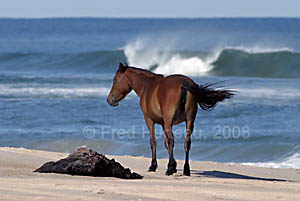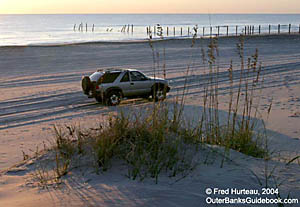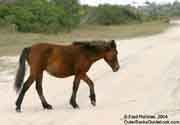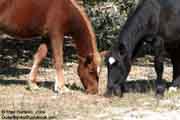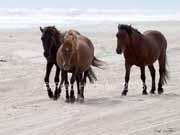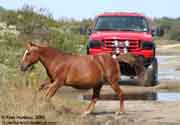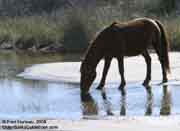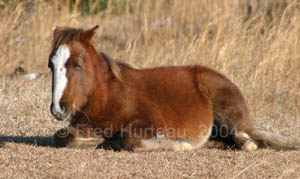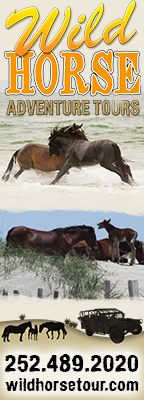 |
|||||||||||||||||||||||
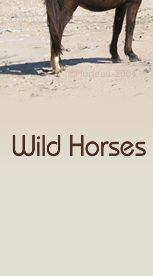 |
 |
||||||||||||||||||||||
In the past these wild Spanish mustangs have roamed freely around Corolla and much of Currituck Banks north of Southern Shores. Before N.C. Hwy. 12 was extended from Duck north to Corolla, this village and its lighthouse were more remote than the northernmost reaches of Currituck Banks around Carova are today. Like Carova and the other northern beach communities of today, Corolla was then reached only by boat or by driving up the beach for many miles. But now there are paved roads and thousands of homes on Currituck Banks north of Southern Shores, up to Corolla. It was this explosion of population and traffic which eventually forced the wild horses north, for their own safety, into a protected area away from highways and speeding cars.
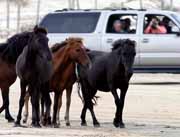 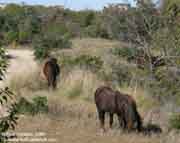 It
is not so difficult to see the wild Spanish mustangs for yourself
if you have a 4WD vehicle and know where to look. Of course, not everyone
comes to the Outer Banks with their own 4WD. But all is not lost.
The other option is to reserve a seat with a guided tour service,
such as Wild
Horse Adventure Tours. They know where to find the wild horses
and have the means to get you there. All you have to do is bring your
camera. It
is not so difficult to see the wild Spanish mustangs for yourself
if you have a 4WD vehicle and know where to look. Of course, not everyone
comes to the Outer Banks with their own 4WD. But all is not lost.
The other option is to reserve a seat with a guided tour service,
such as Wild
Horse Adventure Tours. They know where to find the wild horses
and have the means to get you there. All you have to do is bring your
camera. 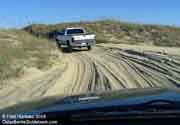
There are no ditches here, so large, very large, puddles abound. Judicious caution should be used when traveling these roads. Usually there is a sandy path around the worst of the puddles, worn to one side of the road or the other to bypass the water. Depending upon how much rain has fallen in recent days, the puddles may be quite easily driven through, but they might also be deep enough to drown out the engine. It's wise to err on the side of caution. 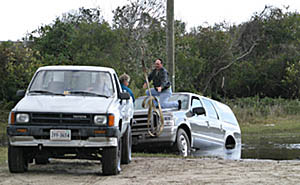 The
driver of the big SUV in this photo was not so prudent and quickly
succumbed to the hidden danger of the large puddles you can find on
the sand and dirt roads around Carova. One puddle can be six inches
deep, and the very next one can be two or three feet deep. You cannot
tell by just looking. If you see someone else drive through safely,
you could chance following their path, but only if you have a real
4WD off-road vehicle. Otherwise, the best advice is "don't try it."
The
driver of the big SUV in this photo was not so prudent and quickly
succumbed to the hidden danger of the large puddles you can find on
the sand and dirt roads around Carova. One puddle can be six inches
deep, and the very next one can be two or three feet deep. You cannot
tell by just looking. If you see someone else drive through safely,
you could chance following their path, but only if you have a real
4WD off-road vehicle. Otherwise, the best advice is "don't try it."Tips on finding the wild mustangs, and what to expect going up the beach to Carova are next. Then there is the "Wild Horse Gallery", with many great photos.
|
|||||||||||||||||||||||
| The
Wild Horses of Corolla Finding the Wild Horses of Corolla The Wild Horses of Corolla in Pictures Gallery of WIld Horses of Corolla Related Links - Corolla Wild Horse Fund Wild Horses of Corolla Photo Gallery - Page One Page Two Page Three Page Four Page Five
 Beach Ramp access map and information |
|||||||||||||||||||||||
|
|||||||||||||||||||||||
| |
|||||||||||||||||||||||
